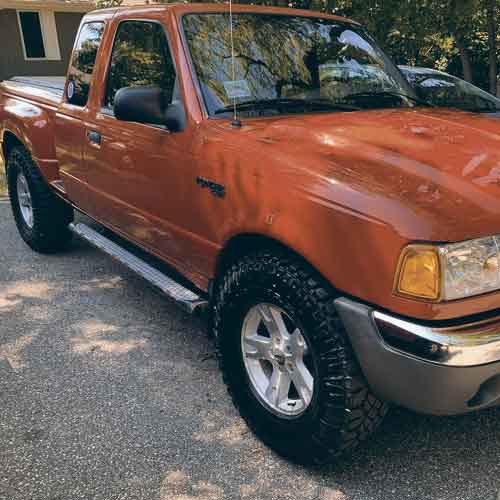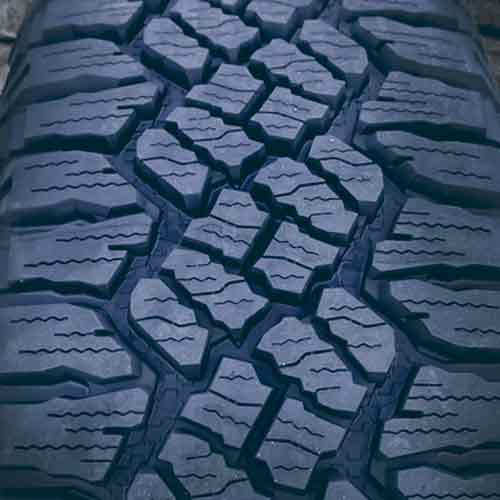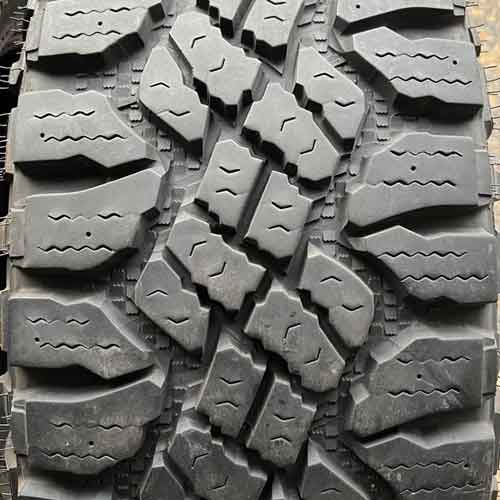The Goodyear DuraTrac RT is a noteworthy update to its predecessor, with improved sidewalls, stone ejectors, enhanced siping, and increased durability. But is it significantly better now? Let’s find out.

Key Takeaway
The Goodyear DuraTrac RT (newer model) excels in:
- Winter Performance: Offers better traction on snow and ice.
- Durability: Enhanced with a 3-ply polyester casing and DuraWall technology.
- Off-Road Traction: Superior performance especially in muddy terrains.
- Wet Braking: Improved capabilities due to its advanced siping structure.
- Noise Reduction: Although still louder, better in comparison here.
While the older DuraTrac variant excels in:
- Dry Performance: Better longitudinal grip, due to its lighter construction.
- Wet Handling: Superior in overall wet handling because of its higher silica composition.
- Steering Responsiveness: More responsive steering, especially in LT sizes, due to a lighter and less bulky design.
- Road Smoothness: Provides better absorption of road disturbances, owing to its softer internal construction.
Side Note: DuraTrac RT has surpassed its previous variant, as the top A/T tire for mud in my list of the best all-terrain tires. You can view the complete list here: https://tiredriver.com/best-all-terrain-tires/
Sizes Specs
The new Goodyear Wrangler DuraTrac RT comes in 42 sizes, from 16 to 20 inches rims. These sizes have following specifications.
- Speed ratings: R, S, T and Q.
- Load ratings: SL, XL, E and F.
- Weight: 42 to 85 lbs.
- Tread depth: 16 – 18/32″.
- UTQG: 500 B B.
- Treadwear warranty: 50k miles on all sizes.
Review new DuraTrac RT here.
On the other side, the older DuraTrac offers 15 to 22 inches rim diameters, having following specs.
- Speed rating: P, Q, S and T.
- Load rating: SL to F.
- Weight range: 35 to 68 lbs.
- Tread depth: 16 to 18/32″.
- Treadwear warranty: 50k miles, but only for P metric sizes.
- UTQG: 500 B B.
- Studable lugs, on LT sizes.
Review older DuraTrac variant here.
Also both tires offer 3PMSF and M+S ratings.
Tread Design
The new Goodyear DuraTrac RT, while bearing resemblance to its predecessor, displays some subtle differences.

Starting with the central lugs, although they maintain a three-pair block configuration, they are slightly larger and possess more biting edges.
Though the most significant change lies in their siping design, which is more aggressive here, with a wave-like pattern, complemented by additional linear sipes.
Other than that, things remain common with the older variant. I mean you get similar, prominent circumferential grooves, with biters on them (on the base of the tread), providing superior off-road bite, especially when it comes to softer terrains, like mud and snow.
The shoulder lugs also follow a similar pair-wise arrangement but with subtle variations.
They exhibit more streamlined, laterally-oriented angles and squarer shapes. Moreover, they also feature middle-facing notches and more pronounced siping, in comparison.
Regarding the sidewalls, the staggered shoulder design includes in-block notches on the edges, extending to form competent sidewall lugs. Though they could still benefit from further improvement.
But of course, they are definitely a step up considering older DuraTrac.

As you can see, this tire comes with a very less aggressive sidewall design, with not so prominent, in-block notches.
Though they have similar staggered shoulder blocks with mud scoops in them.
These shoulder lugs are less streamlined and have more offset edges, contributing to a louder road noise.
Moving towards the middle, the lugs are pretty much the same, except for their siping design.
Here, they lack the aggressive wave-like siping and linear slits found in the RT variant, as already mentioned.
Other than this, although both tires carry the 3PMSF (Three-Peak Mountain Snow Flake) and M+S (Mud and Snow) ratings, the older DuraTrac also features studdable lugs in LT (Light Truck) sizes, an option not available in the newer model.
Overall Dry Performance
To fully appreciate an all-terrain tire’s dry performance, analyzing its longitudinal gripping power and cornering efficiency is a must.
Let’s take a look at both these aspects separately.
Longitudinal Grip
This grip tells you about the tire’s ability to provide traction when moving in a straight line. So the more the tire offers this grip, the better it would be at braking.
The central tread plays a big role here because it’s the part of the tire that’s always in contact with the ground when you’re driving straight. Those central lugs really make a difference in how much traction you get.
BTW: If you’ve got any questions about this, feel free to drop them in the comments below.
Now, the new DuraTrac RT has made some impressive strides in this area. When you switch from the older tire to the newer one, you’ll notice a significant boost in grip, leading to better braking and with it, shorter stopping distances.
Let me give you an idea…
On average, the new DuraTrac RT stops 2 feet shorter in 50 to 0 mph braking tests compared to similar sizes of the older tire.
Now, I know what you’re thinking… that 2-foot difference is pretty small right?
Well yea, you’re right and that’s because while the older DuraTrac has the advantage of being lighter, which helps reduce momentum, the new DuraTrac RT makes up for its added weight with a more compact and advanced tread design.
Overall Handling
When it comes to handling, especially during cornering, a tire’s grip largely depends on its shoulder area. That’s because, during a turn, most of the tire’s weight shifts to the tread’s edges.
The newer DuraTrac RT, with its more streamlined and densely packed shoulder lugs, provides a better contact patch on the edges. This design improvement translates to better lateral traction when cornering, which we can measure through lateral g-forces.
So, how much of a difference does it make? Well, on average, the DuraTrac RT shaves nearly half a second off lap times compared to the older DuraTrac.
But, there’s a bit of a trade-off. The heavier DuraTrac RT can cause some understeering issues because the extra weight creates more momentum, making the steering a bit more sluggish. This is especially noticeable in the LT sizes, where the weight difference is most pronounced.
Despite these understeering issues, the new DuraTrac RT generally outperforms the older model when it comes to overall handling. The improved grip and traction on dry roads make the DuraTrac RT the better choice overall.
Wet Performance
Wet performance hinges on effective water clearance, primarily achieved through sipes and grooves. Grooves are responsible for removing the majority of water, while sipes, which are small slits, absorb the remaining moisture as they compress against the road.
In terms of grooves, there isn’t much difference between the two tires. However, since the DuraTrac RT now features a more advanced siping structure, it offers better wet braking compared to its predecessor.
Despite this, the older DuraTrac still leads in overall wet handling. This is because the effectiveness of sipes is linked to their flexibility. Among the two, the older DuraTrac, with its higher silica composition, exhibits superior water absorption capabilities.
It’s important to note, though, that this distinction is more pronounced in LT (Light Truck) sizes. I mean for P-metric (Passenger) sizes, both tires deliver similar results, particularly in terms of their under/over steering balance.
Winter Performance
The effectiveness of a tire in snowy conditions depends on its ability to maintain forward momentum, handle corners, and respond to braking on various surfaces.
And here, both of these provide everything which makes all-terrain tires do good in snow, providing excellent traction in soft snow and offering 3-peak ratings.
This is largely due to their Tractive Groove Tech. (discussed in their tread design), which capture and retain snow particles, creating snow-to-snow contact that enhances grip.
However, with my subjective evaluations, DuraTrac RT ends up achieving better overall winter scores.
I mean, the RT tire features a more sophisticated siping structure, combining linear and wave-like siping slits in the middle, with more aggressive interlocking structures on the shoulders. This design results in improved performance on packed snow and icy tracks.
Moreover, the tire’s better tread edges design, with more aggressive scooping lugs, provide enhanced performance in deeper snow, particularly in terms of acceleration. These shoulder/sidewall lugs effectively shovel the snow backwards, generating forward momentum.
Though the older Wrangler DuraTrac does have the benefit of studable lugs (on LT sizes). So one can get more out of them, on icy terrains.
Durability
The durability of off-road tires, especially in terms of puncture resistance, hinges on their internal construction and the quality of the exterior rubber.
Having said that, the older, less durable, DuraTrac is missing with both of these features. Despite having a hybrid structure, and aggressive mud-terrain tires like shoulder blocks, the tire only comes with basic 2-ply polyester carcass, accompanied by two belts and two nylon cap plies.
In contrast, the DuraTrac R/T, though sharing the 2-ply nylon and 2 steel belts configuration, offers a more robust 3-ply polyester casing, which enhances protection of the weakest part of the tire, sidewalls.
And while these sidewalls have thicker lugs on top, further adding to their durability, the Goodyear’s DuraWall technology is the cherry on top. It reinforces the sidewalls, with a high turn-up structure, meaning the (internal) plies extend higher, adding durability along with stability.
And yes, worth reminding, the tire also features DuPont Kevlar, which provides its tread rubber with better chip resistance properties.
Side Note: Speaking of durability, make sure to check out – Are All-Terrain Tires Harder To Puncture?
Off-Road Traction
For off-road tires, self-cleaning capability and durability are essential for optimal performance across diverse terrains. Let’s divide this section in three main terrain types.
On Muddy Trails
While both tires are equipped with wide, interconnected circumferential channels for mud expulsion in all directions, leading to similar self-cleaning properties, the Goodyear DuraTrac RT stands out in overall performance.
Although both tires come with Tractive Groove Technology, which breaks down mud particles for quick expulsion, the RT variant still stands out with its robust shoulder design and streamlined grooves for improved mud ejection. It also includes stone ejectors (missing in older variant), enhancing mud clearance further.
Though main difference comes form the R/T tire’s better U shaped sidewall lugs.
This design allows it to better “paddle” through more challenging muddy terrains, effectively pushing mud backward and thus generating forward momentum.
In other words, you can say, the newer tire offers better “getting-out-of-the-mud properties” in comparison.
On Sandy Dunes
Navigating sand requires not only skillful driving but also a tire that is light enough to provide an optimal contact patch for interacting with the sand.
And out of both tires, the older DuraTrac falls short here. And this again has to do with its very less aggressive sidewalls.
I mean even though its a hybrid design, its sidewalls are the least aggressive in its category.
On the other hand, the Goodyear DuraTrac RT, offering enhanced rubber-to-sand contact excels here, particularly with lowered air pressure, where the tire expand out its lugs, making it less susceptible to digging out of both tires.
I explained it further in “All-Terrain tires on sand” – https://tiredriver.com/are-all-terrain-tires-good-on-sand/
On Rocks
Durability is crucial on rocky terrains, and the newer DuraTrac RT really shines in this department. The 3-ply sidewalls and thicker lugs do a great job of deflecting sharp objects, so you’re less likely to get a puncture.
But there’s more to the story. On rocky terrains, the older DuraTrac’s sidewall lugs flex better thanks to a softer rubber compound and their shape provides excellent directional grip.
But yes, at the end of the day, me and my team at CompareTheTire.com still decided to go with the newer tire here, mainly because of its more durable built (talking about sizes having DuraWall technology) as those are the only ones with 3 ply sides.
And yea since both tires have powerful rim locks, you can make sides as flexible as you want by lowering the air pressure further. Though of course there is a limit, that’s I why if you’re new to airing down, read this article first.
Overall Ride Comfort
Ride quality in a tire is gauged by its ability to minimize road vibrations and noise, thereby enhancing the smoothness and comfort of the driving experience. Let’s see how both tires performed in each of these key areas.
Road Smoothness
Addressing road vibrations involves several factors, with the tire’s shock-absorbing capacity and overall stability being the most crucial.
These aspects are heavily dependent on the tire’s overall design.
In this respect, the Goodyear DuraTrac RT, featuring a stiffer rubber compound, does not particularly excel, here.
In contrast, the older version, with its less durable, yet softer internal construction and, pliant rubber top layer, provides better absorption of road disturbances.
I discussed it further here: https://tiredriver.com/do-all-terrain-tires-cause-vibrations/
Noise Comfort
Tread noise arises from various factors, such as the type of rubber-to-road contact, surface friction, lug density, and the external construction of the tread.
And in all these variables, air plays a significant role. Essentially, air enters through shoulder voids and strikes the surrounding walls, leading to in-groove resonance, tread vibrations, and cavity sounds.
Now, with its more streamlined shoulders, (as discussed in its tread design), the Goodyear Wrangler RT slightly better performance in this regard.
Though the tire remains somewhat noisy, compared to many other tires in its category, and still needs further improvements.
This is because DuraTrac RT emits a lot of growling noise, particularly, but yes, it’s still quieter compared to the older variant, as seen by its lower decibel reading tests, on average.
Fuel Economy and Tread Life
Both of these are impacted by various factors, with the tire’s weight, material composition, and tread depth being the most significant.
Having said that, despite the newer DuraTrac RT having a heavier overall construction, which exerts more pressure on the lugs, it does not wear out as quickly in comparison.
This is due to its stiffer rubber composition and Kevlar reinforcements, enhancing its chip resistance and durability.
So you get better tread life on the RT variant, which is particularly noticeable in LT (Light Truck) size comparisons.
I mean comparing P-metric sizes, the overall difference in their longevity is relatively smaller, which makes sense as both tires offer similar 50k miles warranty for those.
Though its not the same scenario, when it comes to fuel economy, as DuraTrac RT, with its greater weight generates a lot more rolling resistance, bringing overall mpg reading lower, relatively.
Wrapping Up
So overall, it all comes down to this.
While P metric sizes perform similar on roads, in terms of LT sizes the new Duratrac offers superior dry performance and older version is slightly better on wet.
Other than that…
The older variant also excels in terms of road comfort and fuel economy, though lacks when it comes to dampening on-road noise.
And, yes, off-road, the Duratrac RT excels, which is not a surprise, given its more powerful sidewalls and internal construction.
Though there’s still room for improvement on rocky terrains.
You mention the RT has a different rubber composition. I watched the Youtube video by Tyre Review where Dennis from Goodyear states the compound is the same. Can you confirm it is a different compound?
Yes its different. There are a lot of things at play here, and it may be same on paper…but its different.